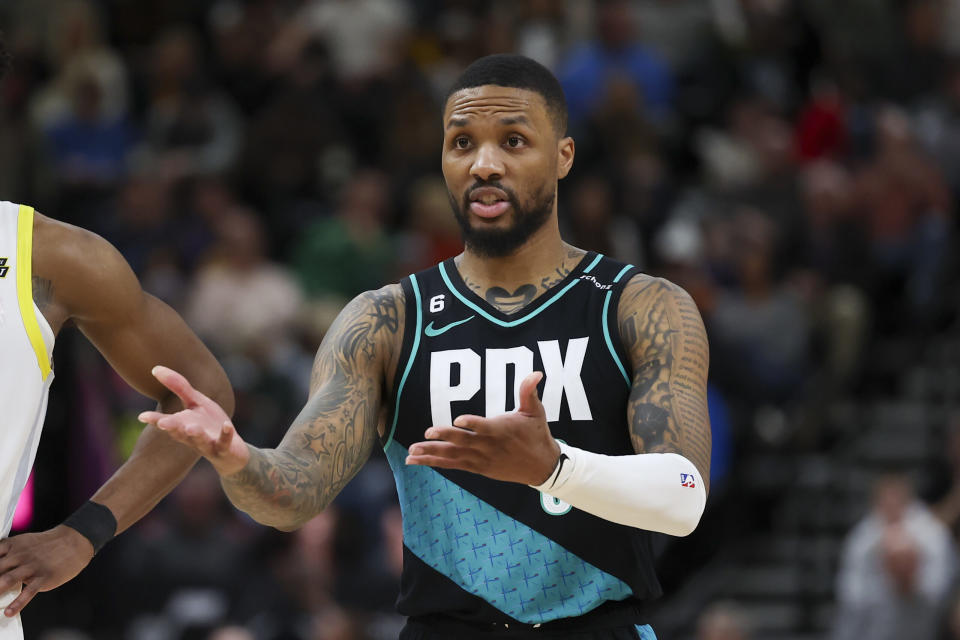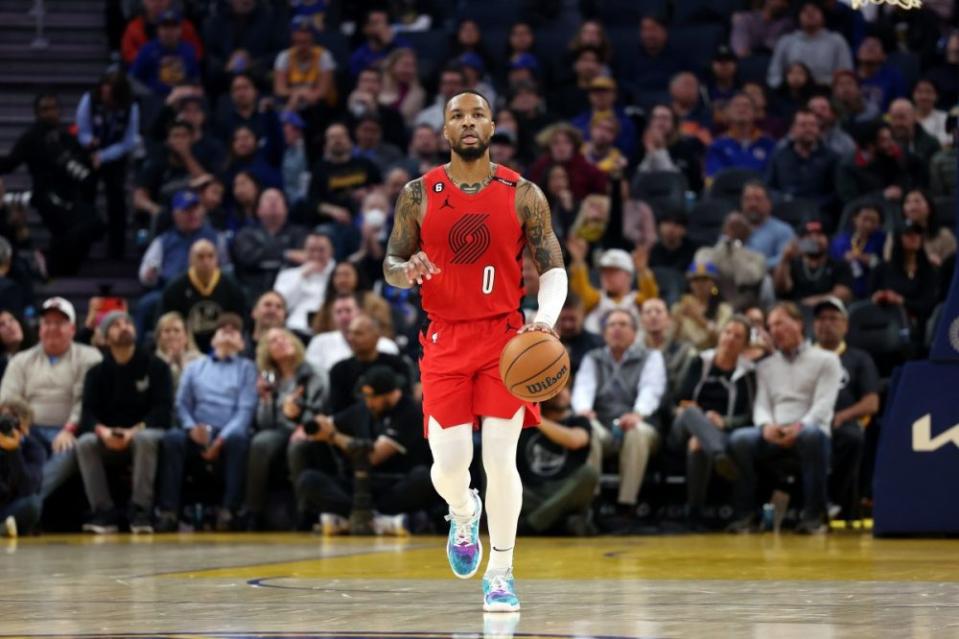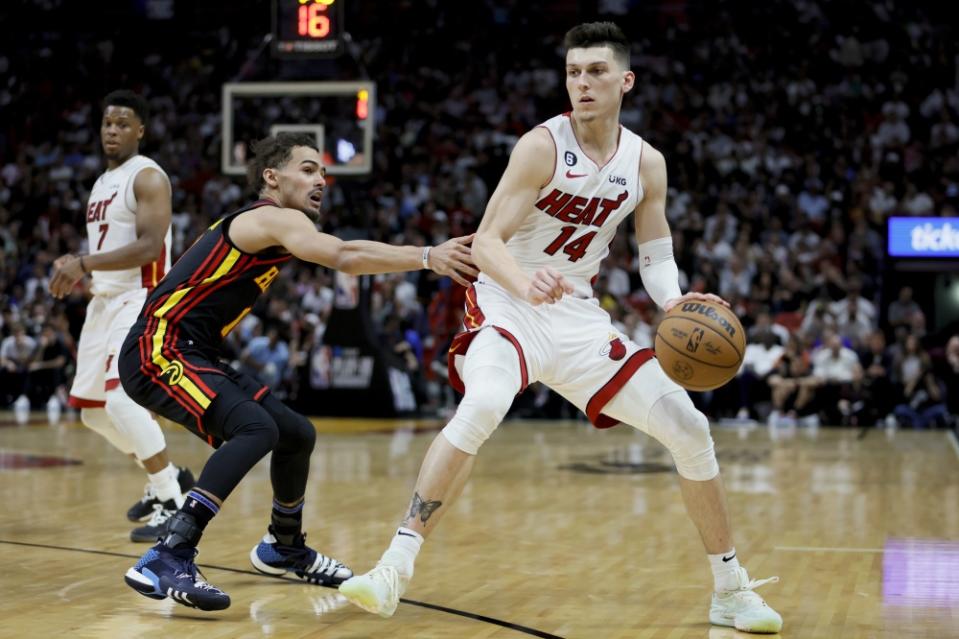Damian Lillard to Miami? Tyler Herro to Brooklyn? Here’s how the trade could look like

Free agency came and went within the first 72 hours like usual, but there are still some major dominos yet to fall. Notably, Damian Lillard requesting a trade to Miami, which could limit Portland’s return.
Of course, the Blazers don’t have to honor his demand one year after extending for two years. Lillard’s four seasons remaining on his contract could sway other interested teams from topping the Heat’s best possible offer. The Nets, Celtics, Spurs, and Jazz are just some teams that could easily offer more draft equity and prospects, which the Blazers reportedly are prioritizing.
If the Heat do end up acquiring Lillard, it would almost certainly require sending out Tyler Herro. However, a third team will likely be required to acquire him since the Blazers reportedly aren’t interested in him. One of the more popular frameworks being floated around is a three-team trade with the Brooklyn Nets, who reportedly are interested in Herro.
Below is an explainer of what is required from the Heat and Nets to land their targets, and how existing trades they agreed to that aren’t official yet could help.
Salary matching component

The Heat have been operating this offseason in a holding pattern in preparation for a potential Lillard trade. Their moves so far have been limited to signing first-round pick Jaime Jaquez Jr., who now cannot be traded for 30 days, and minimum signings. They’ve been on the hunt for great values at the minimum with the additions of Josh Richardson and Thomas Bryant. They also re-signed Orlando Robinson and will re-sign Kevin Love with the Non-Bird exception.
The team has restricted themselves to minor moves to retain flexibility for potentially exceeding the second tax apron. Should they acquire Lillard, it’s likely they will increase their payroll and surpass the $182.8 million threshold. Using any portion of their mid-level or bi-annual exception, or increasing payroll in a trade by more than 10 percent not only would hard cap them to the second tax apron, but also the $172.3 first tax apron.
The Heat are set to be just $1.9 million below the second tax apron once all their reported moves become official, including the trade of Victor Oladipo to the Thunder. With no guarantee they can significantly decrease payroll by offloading multiple salaries like Kyle Lowry‘s $29.7 million and Duncan Robinson‘s $18.2 million, they need to operate as if a Lillard acquisition will take them over the second tax apron.
For this season only, there is a Transition Traded Player Exception that allows teams above the first tax apron to increase payroll by no more than 10 percent in a trade. This would require the Heat to send back $41.5 million in outgoing salaries to match Lillard’s $45.6 million for 2023-24. There are multiple ways they can reach that number, including with players that they have already agreed to trade.
The Nets, meanwhile, have been hard at work significantly reducing their payroll and increasing flexibility as much as possible. They agreed to trade Joe Harris to the Pistons in a salary dump that essentially will be replaced by Cameron Johnson’s four-year, $108 million deal. They also are trading Patty Mills to the Rockets without taking back any salaries. They’ve limited increasing their payroll to signing Dennis Smith Jr. and Lonnie Walker IV to minimum salaries that will only add $2 million cap hits.
All these moves, along with the eventual signings of first-round picks Noah Clowney and Dariq Whitehead, will leave the Nets with 14 players and well below both the luxury tax and first tax apron. It seems unlikely that they will go above either threshold after three consecutive seasons with exorbitant tax penalties. If they finish over the tax again this season, they’d be in the repeater tax, which gives higher penalties. That could be a non-starter for a Nets team that was just a No. 6 seed last season.
With Brooklyn likely set to operate below the first tax apron, they can take advantage of the looser trade rules for teams in their position. One of the modifications is that teams below the first tax apron can increase payroll by $7.5 million if their outgoing salary is between $7.5 million and $29 million. Since Herro earns $27 million this season, the Nets would only have to send out $19.5 million to match for him. They have a multitude of salary combinations they could make to match for him, but they may have already done so with a trade they agree to.
How existing trades can accomodate a Lillard and Herro trade

If the Heat, Nets, and Blazers were to do a three-team trade, the Blazers would almost certainly need to take back significant salaries in return. They may have to take back a combination of players from both teams like Lowry, Robinson, or Ben Simmons. Portland would likely prefer a third or fourth team get involved to take on salaries from Miami and Brooklyn, but that could require additional assets from both those teams.
But what if the Heat and Nets didn’t have to send out more salaries and just had to send draft equity and prospects to the Blazers? And what if the Blazers didn’t have to take any significant salaries back? Those scenarios are very much in play thanks to trades the Heat and Nets have already agreed to that can’t become official until after the moratorium period ends on July 6.
The Heat have already agreed to trade Oladipo to the Thunder, as well as sign and trade Max Strus to the Cavaliers. Oladipo has a $9.5 million salary, while Strus’ salary is expected to be around $14.6 million. Base Year Compensation rules would limit Strus’ outgoing salary from the Heat’s perspective to half that amount. Those two outgoing salaries, combined with Herro’s $27 million, would cover the $41.5 million required by the Heat to match for Lillard.
The Nets are also in a similar position with their agreed-upon trade to send Harris to the Pistons. His $19.9 million salary is just enough to cover the $19.5 million required to match Herro’s $27 million. If the Nets and Heat were to combine their existing trades with Pistons, Thunder, Cavaliers, and Spurs into a seven-team deal with the Blazers, neither the Nets nor Heat would need to send out any additional salaries.
While a seven-team trade is unprecedented and unlikely, the possibility for the Heat and Nets to combine some of their current trades with this hypothetical one exists. For the Heat, they avoid needing to find a team to take on the salaries of Lowry or Robinson and preserve them for future trades. As the season goes on, Lowry’s expiring contract will be easier to trade and break up into smaller pieces.
The same idea applies to Brooklyn, though they would still need to reduce their payroll afterward to stay under the tax and apron. They could move off a player such as Royce O’Neale or Dorian Finney–Smith, who have been mentioned in trade rumors, to accomplish that. They could alternatively reel in their Mills trade to Houston by aggregating him and Harris for Herro. That would increase payroll by less than 10 percent, allowing the Nets to go over the apron if they want.
For the Blazers, such a framework would avoid having to take back negative value salaries. In fact, they would only need to take back the draft equity and minimal salaries in the form of the prospects they desire. They could potentially generate a trade exception around the range of Lillard’s $45.6 million salary, giving them a ton of trade flexibility over the next year.
You can follow Yossi Gozlan (@YossiGozlan) on Twitter.

 Yahoo Sports
Yahoo Sports 
